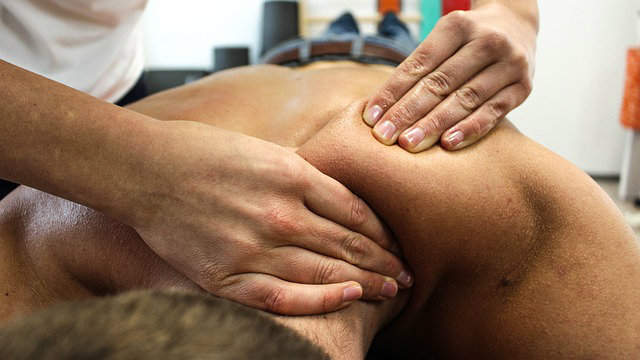 Reading Time: 7 minutes
Reading Time: 7 minutesAccording to the American Chiropractic Association, at any given time, 31 million Americans experience lower back pain. In general, back pain is one of the main reasons that Americans miss work. It is also the second most common reason for Americans to see their doctor.
The good news is that most back pain is not caused by a serious issue, like fracture, arthritis, or any type of chronic condition. In other words, there are things you can do about your back pain to improve it, and this goes for shoulder and neck pain as well — they’re all related.
Of course, seeing a healthcare provider or specialist is always an option, and if your back, neck, and shoulder pain are linked with a disease, disorder, or condition, you should always follow the advice of your doctor.
But reaching for a bottle of pain pills should not be our go-to solution unless our doctor suggests it. Pain medications have serious side effects as well as long-term health consequences — while they can help us cope, they don’t necessarily bring us closer to a solution and living a truly pain-free life.
Instead, consider exercise as a way to improve your back, neck, and shoulder pain — to take proactive role in how you feel. The exercises outlined below are things you can do yourself and on your own time. And the “side effects” of this prescription are minimal: a healthier heart, stronger muscles, more energy, and a better overall mood.
Not so bad. Ready to get started?
1. Cardiovascular Exercise for Back Pain
Cardio exercise helps with back pain by reducing stiffness and increasing blood flow. Like any part of your body, your back and shoulders require consistent movement to stay in working order, without pain.
“But I’m on my feet and moving all day,” you say? “You run X times a week,” you say? In fact, you’re probably not moving the necessary muscles to help with back pain. Having an on-your-feet job and running are great, but they require only specific and isolated movements. They don’t twist or rotate your spine.
Try these exercises instead:
- Swimming: Perfect for those who have trouble with other joints (hips, knees, ankles), swimming is the ultimate low-impact sport. Even if you’re not an avid swimmer, just treading water and swimming around at your leisure for at least 10 to 20 minutes a day will work out the muscles that surround your spine and warm them up, increasing blood flow and helping them to relax.
- Daily walking: Walking every day is a great way to build a habit of regular movement — especially if you’re not usually active or don’t have a lot of time. Daily walking increases circulation and is a great way to build your spine health.
- Other cardio exercises for back, neck, and shoulder pain: It may sound a bit crazy, but dancing is a great way to reduce back pain because it requires consistent movement of the entire spine, including the neck and shoulder area. Finally, you might also consider more demanding, all-body sports like soccer, volleyball, and basketball.
2. Muscle-Building Exercises for Back Pain
The Bird Dog
The bird dog movement builds the muscles around your core and spine. When your core is stronger, it can do a better job of supporting your structure and helping you maintain good posture for longer periods of time.
- Start on your hands and knees with your knees beneath your hips and your wrists and elbows beneath your shoulders.
- Keep your head down and lift your opposite leg and arm (e.g. your right leg and left arm).
- Hold for a count, then bring both limbs together (elbow to knee at your core).
- Do 5 to 15 reps on each side for 2 to 3 sets.
The Pelvic Tilt
The pelvic tilt may appear simple and easy, but it’s great at engaging the lower back, which is where many people experience pain. Part of your pain may be due to your brain not being able to communicate very well with your low back and glutes, and your back not trusting you to move properly in kind.
You can use the pelvic tilt to help your brain and your lower back become better friends, and to strengthen the glutes so your lower back can move in a strong and healthy manner.
- Start by laying on your back on a mat with your hands and arms at your sides.
- Have your knees bent and feet flat on the mat, shoulder width apart.
- Slowly lift your pelvis off the floor and toward the ceiling.
- Rotate your pelvis up, and tuck it under as you tighten your glutes.
- All the while, keep your shoulders and upper back on the mat and eyes toward the ceiling.
- Do this for 8 to 12 reps for 2 to 3 sets.
The Plank
Finally, do the plank. This is one of the most simple exercises to do. It requires no movement, but is extremely effective. It is perfect for everyone from beginner to advanced.
- Push yourself up into push-up position with your wrists directly below your elbows and your shoulders.
- Straighten your knees and keep your feet hip-distance apart.
- Make sure your spine is straight and that your head and neck are in line with your spine.
- Hold the position for 30 seconds, or as long as you can. As you improve, hold the pose for longer.
Note: If the high plank feels too hard on your wrists, you can do a low plank on your elbows. The video explains both versions, as well as options for making the plank both less and more strenuous.
3. Don’t Forget the Importance of Stretching
The exercises listed above strengthen your muscles and simultaneously warm and loosen them up for less pain and discomfort. But in addition to these exercises, stretching should be another essential practice to use.
- Before a workout, do some dynamic stretching for at least 3 to 5 minutes before engaging in your main activity.
- When your workout is complete, cool down with 3 to 5 minutes of static stretching.
You can learn more about dynamic and static stretching by watching this video:
Additional Tips for Back Pain
Stretch in Bits Throughout the Day
In addition to stretching before and after your workout, try to stretch as you go about your day. This is easy to do while you’re reading something on your computer, talking on the phone, or watching television, and it can make a big difference in how you feel overall if you tend to have a sedentary job. It’s important that those who work at a desk all day make it a priority to move and stretch a little at least once an hour.
Work on Your Posture
Speaking of sitting at a desk all day, make sure that you have the optimal setup for your posture. If the natural position you take when you work has your shoulders tensed or at an uncomfortable position, take steps to change this.
Experts recommend the following:
- Have your computer screen at an even eye level
- When typing and using your mouse, you should not have to hunch your shoulders to get your arms over your desk — an under-the-desk roll out keyboard and mouse tray can help
- Your feet should be flat on the floor while you sit
- Your chair should touch and support your back from the lumbar area on up
Try Massage
If pain in your neck, shoulders, and back is serious, seeing a chiropractor or physical therapist can help. Regular massage releases lactic acid from your muscles and reduces and prevents the formation of knots.
If getting regular professional massages is not financially feasible, however, you can also try self-massage. Many people do this while they watch television. Simply rub the uncomfortable areas gently with your finger tips and hands to reduce tension and knots. If your fingers are skidding over your skin, try adding a few drops of essential oil. If the painful area is difficult to reach, try using one of the many massage tools available to work the spot.

Putting in the Work Now — for a Pain-Free Future
Finally, remember that reducing back, shoulder, and neck pain is not just about optimizing comfort now. Certainly you don’t want to live your life in pain, but this type of pain can also easily compound over years and decades, and it can cause serious problems later on. Issues like severe and chronic back pain that requires pain medication, kyphosis (hunchback), arthritis, and migraine headaches can often be traced back — in whole or in part — to uncured pain in your back, shoulders, and neck.
By targeting discomfort in these areas now and using the information above to improve your pain, you are setting yourself up for a more comfortable, pain- and medication-free life as you age. And of course, you’ll be better able to enjoy a pain-free life today and every day.









